Survey: Americans’ cleaning and decluttering habits while stuck at home

Key takeaways
- 72.9% of people admitted cleaning or tidying up immediately before a video call.
- 22.8% of people said they’re considering hiring a home cleaning service once the pandemic ends.
- Facebook Marketplace and eBay were the places people commonly used to get rid of unwanted items.
- 64% of people reported intentionally cutting back on purchases to help keep their home decluttered.
Marie Kondo started a pandemic well before COVID-19 overtook the globe: the tidying up pandemic. The Japanese organizing consultant is perhaps best known for her Netflix show "Tidying Up with Marie Kondo," which was rated the best nonfiction TV release the year it came out. Unsurprisingly, it sparked a wave of other cleaning and decluttering shows in its wake.
If decluttering had a nemesis, however, it would probably be a health pandemic that sparked a surge of hoarding behavior. It's hard to be tidy when you have stockpiles of supplies laying around. But all the hoarding and time stuck indoors may also be good for cleanliness. In fact, the pandemic inspired many Americans to declutter their home.
To examine exactly how the pandemic urged people to tidy their homes – and how they went about doing this – we surveyed over 1,000 people about their cleaning and decluttering habits throughout the pandemic. How are they decluttering their stockpiles? What appliances are they using to clean? And what benefits does having a clean space bring about? Read on to see what we discovered.
Springing into spring cleaning
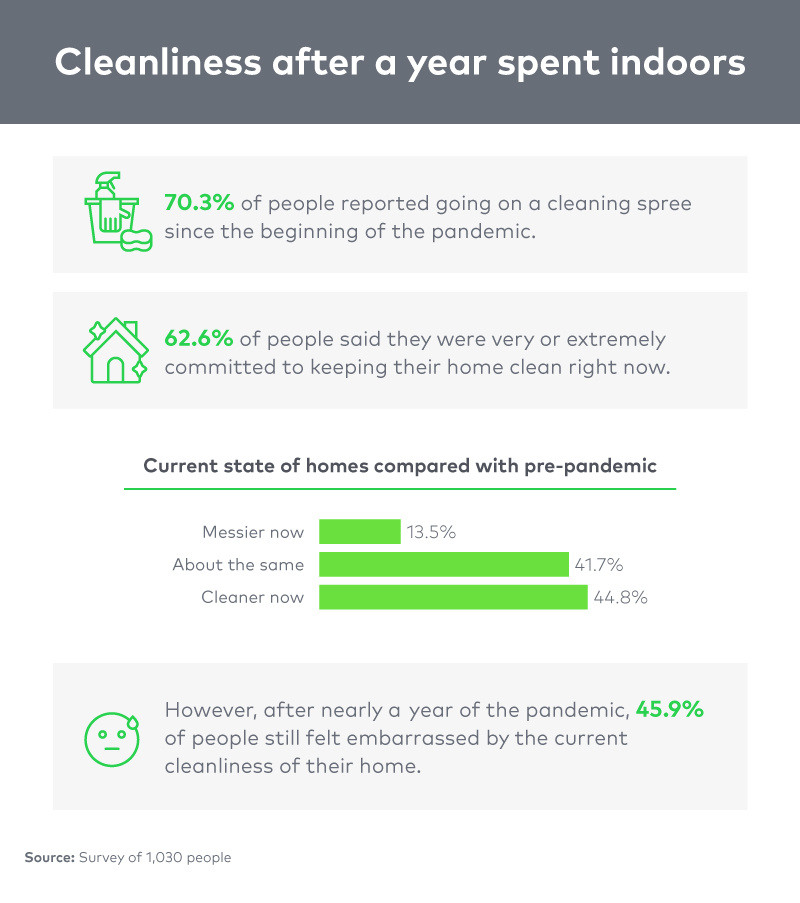
After a year spent largely indoors, many of us may be seeing our messes differently. According to our respondents, the pandemic hasn't just made social hygiene a priority; it's also brought home cleanliness front and center. Nearly two-thirds of people surveyed said they were very or extremely committed to keeping their home clean right now.
This may explain why household spending on domestic cleaning supplies increased over 50% in the first six months of the pandemic. There may also be the Centers for Disease Control and Prevention's (CDC) published guidelines on how to clean and disinfect your home to thank for Americans' new devotion to cleanliness.
As a result, nearly 45% of people surveyed said their homes are cleaner than before the pandemic. For just under 42%, things hadn't changed much, and 13.5% of people said their homes are even messier now than before the pandemic.
Despite all of these good intentions, almost half of people said they're embarrassed by the current cleanliness of their home even nearly a year after the pandemic began.
Hoarding vs. decluttering
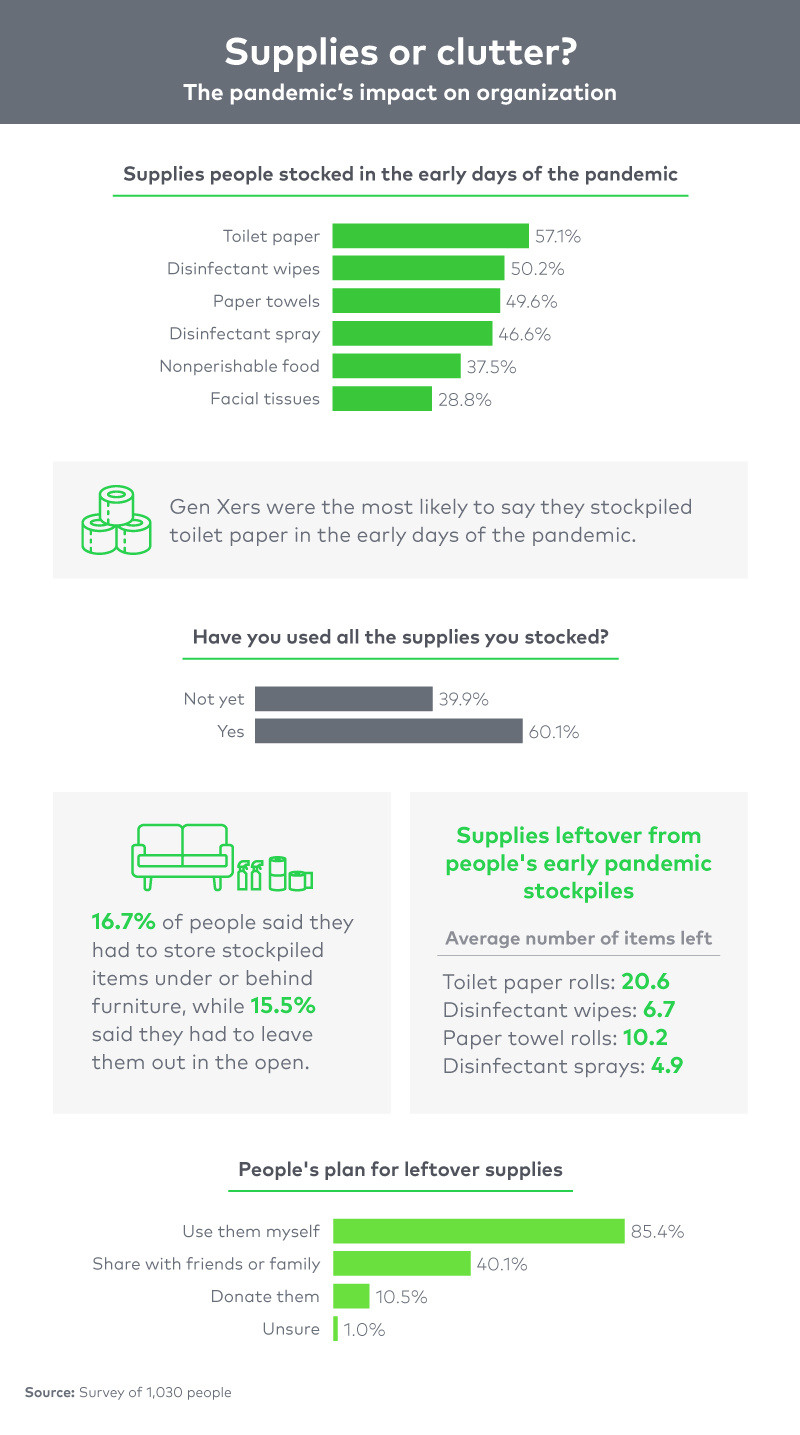
While the cleaning supplies made sense given we've been combatting a highly contagious virus, toilet paper hoarding made some people scratch their heads. According to psychologists, it may have been that there is no substitute for toilet paper. If you run out of rice, you can eat something else, but if you run out of toilet paper you're left up the creek.
A year into the pandemic and almost 40% of people said they still haven't used up all the supplies they hoarded. Nearly 17% of people said they had to store stockpiled items under or behind furniture, and 15.5% said they had no choice but to leave them out in the open. Some more creative minds may try turning their stockpile into art projects; entertain the kids and disguise the mess all at once. The question has now become what is there to do with all these stockpiled goods?
The vast majority of respondents (85.4%) said they were just going to use their leftover supplies themselves. Around 40% of people said they'd share their stockpile with friends or family, and a charitable 1 in 10 had plans to donate their surplus.
How to clean during a pandemic
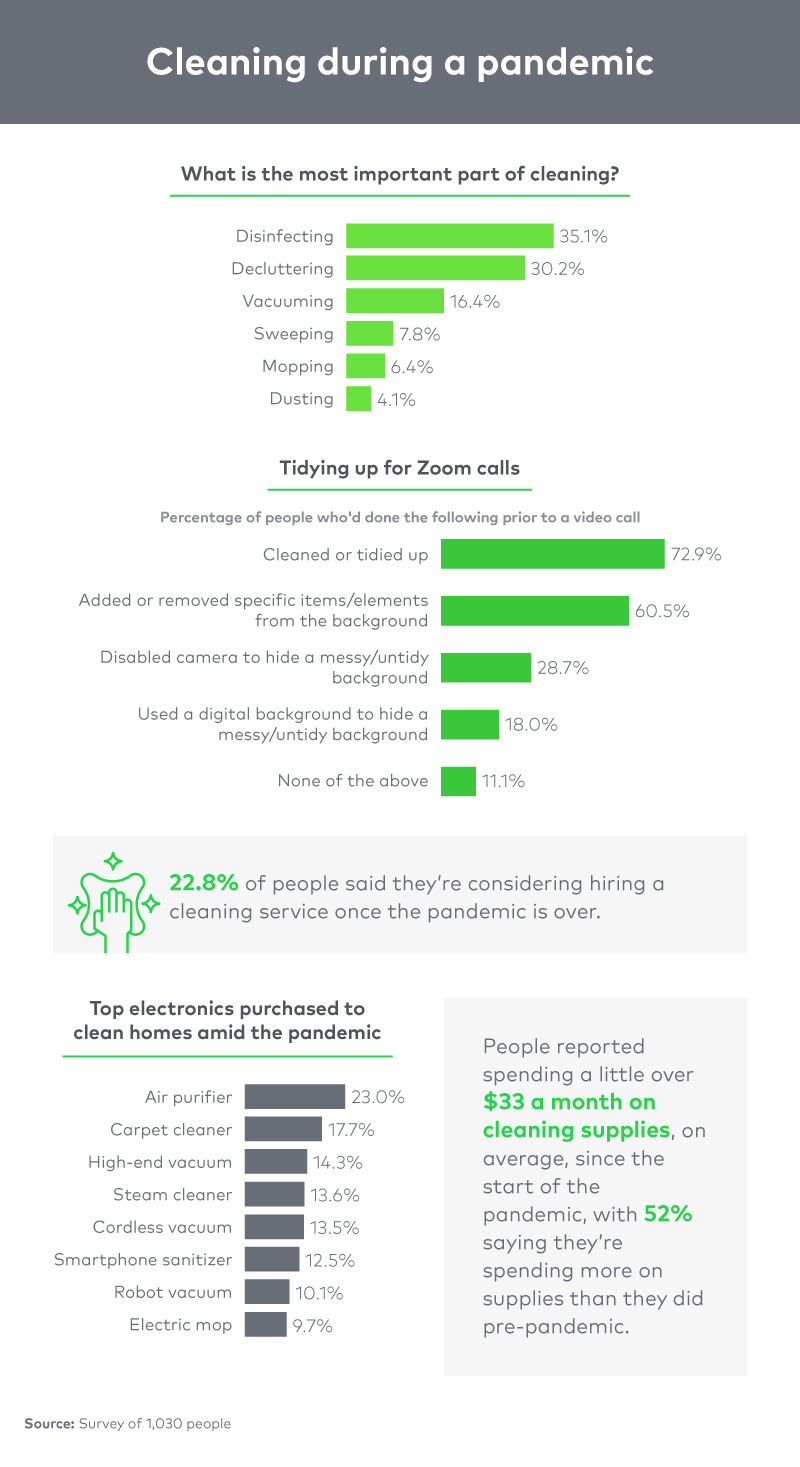
Cleaning can mean different things to different people. For instance, one person may say disinfecting is the most important part of cleaning, while another may say it's about decluttering. According to our survey, most people fell into the former camp, with over 35% saying disinfecting is the most important part of cleaning. Decluttering was a close second, however, with 30% of respondents who named it the most important part of cleaning. Vacuuming, sweeping, mopping and dusting were less important in respondents' eyes.
With the pandemic and work-from-home life, people's homes became less and more public. On the one hand, you had fewer visitors over; but on the other, work Zoom calls meant more people were getting a glimpse inside your home. We asked survey respondents how they handled the Zoom call invasion of privacy. Nearly 73% of people said they had cleaned or tidied up the space where their call was being held beforehand. Over 60% of people said they had added or removed specific items from the background.
Nearly 29% of people resorted to disabling their camera to hide an untidy background. Alternatively, Zoom has a virtual background feature that lets you turn your natural background into a green screen for any number of backdrops. Just under 20% of our respondents said they've used a fake background. A small minority (about 11%) told us they didn't do any tidying up before Zoom calls.
Given how much more cleaning and tidying people are doing since the pandemic, we wanted to know what tools they're using to get the job done. Experts did predict a surge in spending on cleaning equipment and staff as a result of the pandemic, and according to our survey, people did spend more on cleaning supplies during the pandemic. Over half of respondents said they spent more on supplies than before the pandemic with people spending over $33 per month, on average, to buy cleaning supplies.
The most commonly bought home cleaning device was an air purifier, which is fitting given the CDC said the coronavirus can spread through the air. The next most common purchases were carpet cleaners and high-end vacuum cleaners. More people opted for high-end vacuums, like a Dyson, than the cordless variety, and even fewer opted for a robot vacuum. Steam cleaners were popular purchases, and although steam cleaners can be effective in hospitals, experts say they're not as useful for home cleaning during COVID-19.
Decluttering after hoarding
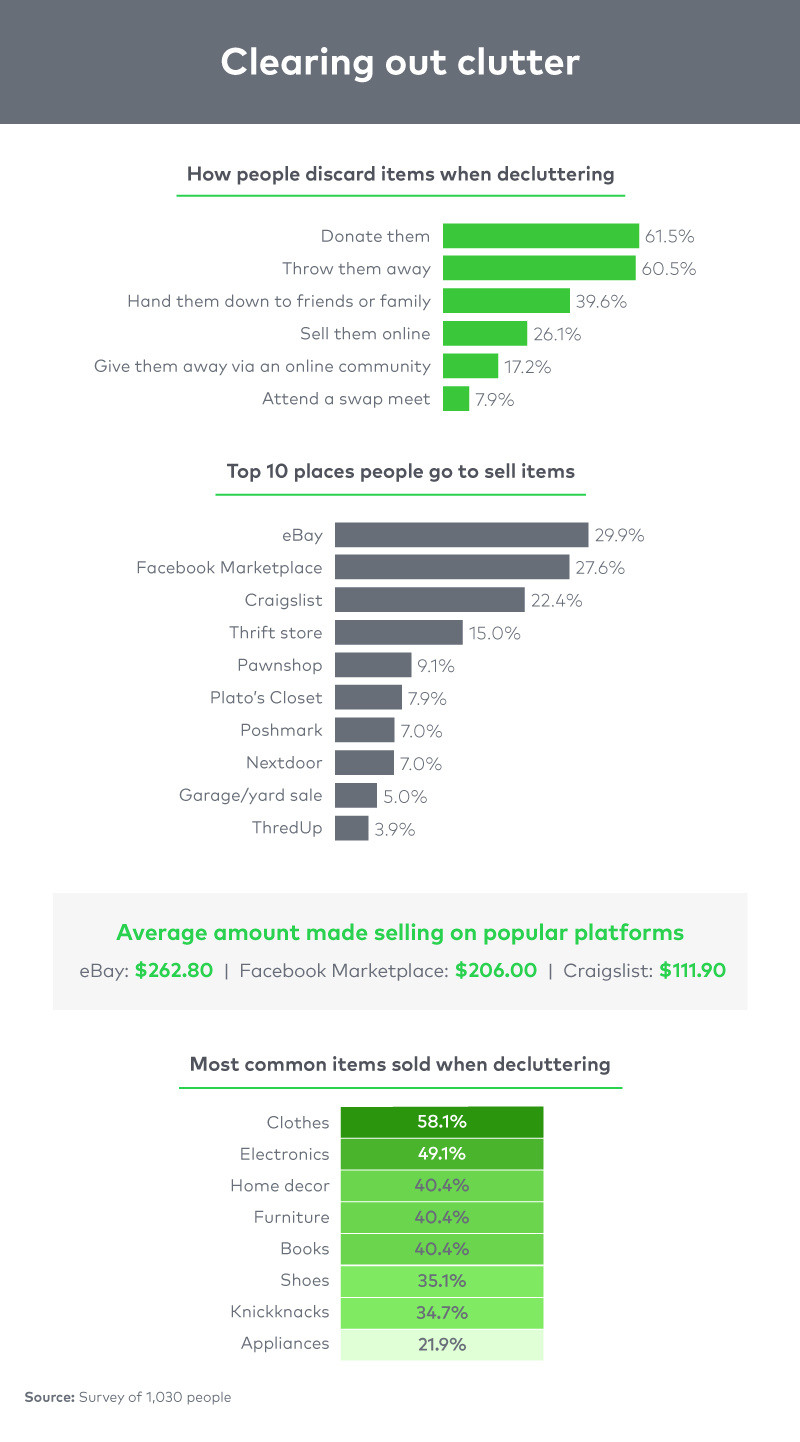
After a year of stockpiling, how do you even begin to declutter? According to our survey, donating items is a great way to be out with the old. While most people said they had donated unwanted items (61.5%), nearly as many said they just threw them away. This is a bit alarming given the impact trash has on the environment, with nonbiodegradable waste being the most detrimental. On the bright side, some power plants are turning garbage into energy. When decluttering, people also turned to gifting by handing down unwanted items to friends or family, a far more environmentally friendly strategy than throwing them out.
One coronavirus trend for the declutterer is selling unwanted items online. Just over 26% of people took this entrepreneurial avenue. EBay may have become the pastime of the pandemic, with over 11 million new customers signing up in 2020, driving U.S. sales up 22%. Unsurprisingly, eBay was the most common place our respondents went to sell unwanted items. They made an average of $262.80 on their sales through eBay, compared to $206 on Facebook Marketplace, the second most popular selling platform. Craigslist was less popular among respondents, netting an average $111.90 in revenue for them. Some people braved the public by going to pawnshops or thrift stores, like Plato's Closet. A few even held garage sales for their unwanted items.
The most commonly sold items during decluttering were clothes, with nearly 60% of respondents saying they sold unwanted apparel. Just under 50% said they sold electronics. Home decor, furniture and books were each equally popular items to sell, with 40.4% of respondents doing so. Just over one-third of respondents said they sold shoes and knickknacks, and just over one-fifth sold old appliances.
The surprising benefits of cleaning
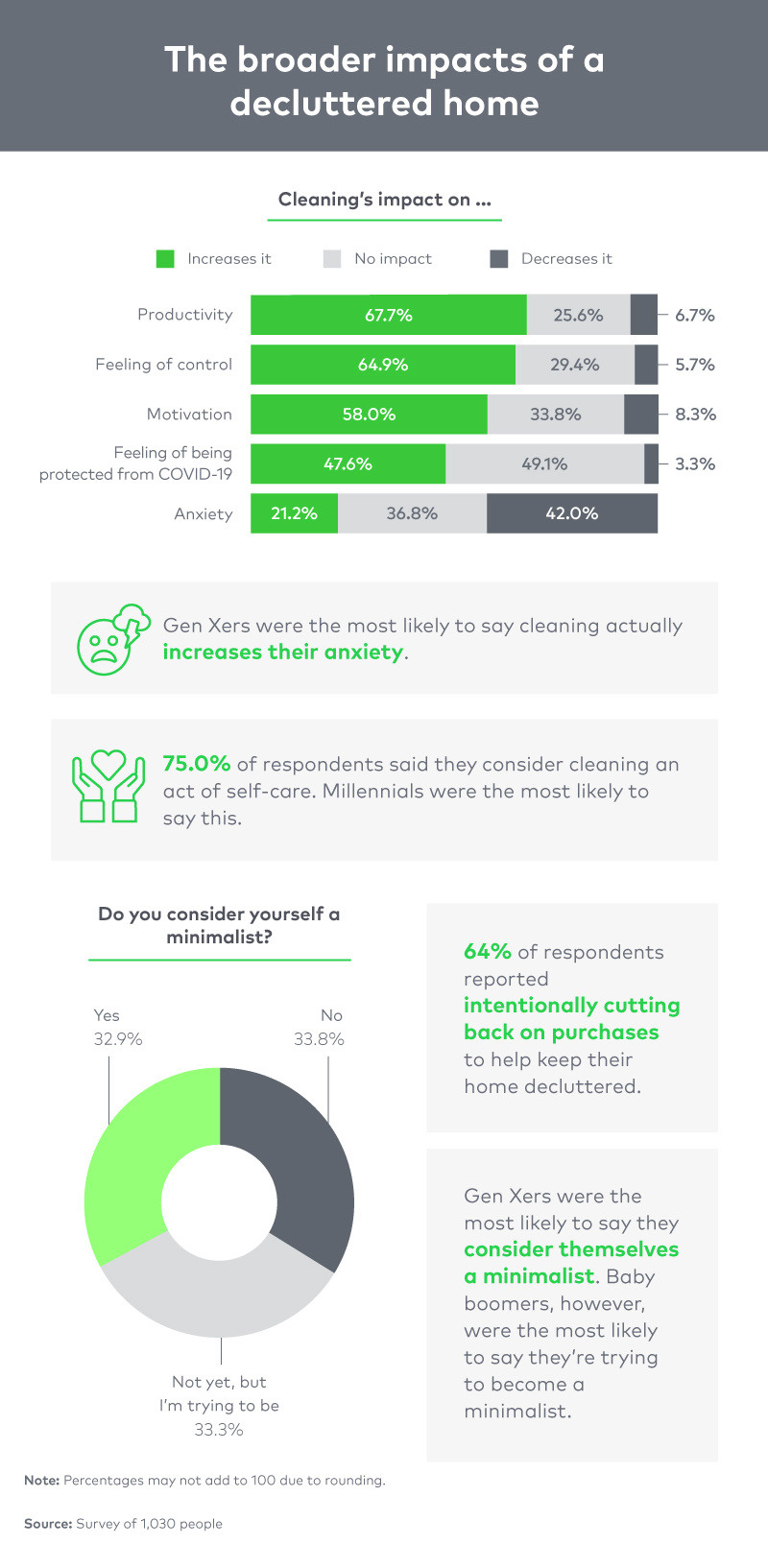
Cleaning can benefit more than just your home. Research has shown that cleaning your living space can have surprising benefits on your mental health as well as your physical health. For instance, studies show decluttering can reduce stress and increase productivity – and our respondents agreed. Over 67% of respondents said cleaning increased their productivity, and 58% said it motivated them. Likewise, 42% said cleaning reduced their anxiety, and nearly 65% said it gave them a sense of control, which has been linked to lower stress levels.
Of course, COVID-19 can't be ignored in the mental health equation of today. Cleaning is especially important during a pandemic for physical health, but our survey indicates it can also have a positive mental impact by increasing your feeling of being protected from COVID-19. With the mental health implications of the pandemic, any actions we can take to feel more secure are likely worth the time and effort.
Given the positive impact cleaning can have on our well-being, is it any wonder that 75% of respondents said they consider cleaning to be an act of self-care? Millennials were the most likely generation to categorize cleaning this way.
To help them keep a decluttered home, 64% of respondents said they are intentionally cutting back on their purchasing. Nearly one-third of respondents have gone so far as to call themselves minimalists, who are defined by being more conscious of the items they own and purchasing decisions they make. Another one-third said they aren't minimalists yet, but they're trying. This suggests minimalism is not the passing trend some may have imagined but instead a lifestyle here to stay.
To clean or not to clean
Having a clean space can bring many rewards: from the physical of sanitation and a decreased risk of allergies to the mental health benefits of feeling more productive and less stressed. While a pandemic may not be conducive to decluttering your home, our survey suggests many Americans were able to take the pandemic as an opportunity to tidy up Marie Kondo-style. Time spent locked down with our own clutter appears to have prompted the need to purge or at least the desire to make money off of the things we don't need.
Of course, cleaning isn't for everyone. Some took a different track by learning to embrace their clutter, which may be the true message behind minimalism: It's not about owning less stuff, but rather about being more conscious of the items we own and buy. Minimalism and materialism can coexist, you just need to have a place for everything and keep everything in its place. Wherever you fall on the minimalist to hoarder spectrum, home organization can help bring peace of mind even during the most tumultuous of times.
Peace of mind can also come from protecting and taking care of your home. Cinch Home Services has you covered in both respects. We offer an affordable and award-winning home warranty that controls the cost of appliance and system breakdowns and can help you hire professionals to help you with home renovation projects and repairs. If you need a repair of any kind, you can schedule it right on our site. We make it easy to pick a home protection plan that works for you and your budget. See how we can help you care for your home.
Methodology
We surveyed 1,030 people about their cleaning and decluttering habits in the home. Respondents were 47.3% men and 52.2% women. Three respondents were nonbinary, one was transgender and one chose not to disclose their gender. The average age of respondents was 40.2 with a standard deviation of 12.9 years.
Data on the supplies people stocked in the early days of the pandemic; what people with leftover supplies planned to do with them; actions people took before video calls; how people discarded unwanted items; where people sell unwanted items and the most common items sold when decluttering were gathered using check-all-that-apply questions. Therefore, percentages won't add to 100.
Limitations
The data we are presenting rely on self-report. There are many issues with self-reported data. These issues include, but are not limited to, the following: selective memory, telescoping, attribution and exaggeration.
Fair use statement
The pandemic and hoarding it caused may seem like the antithesis to cleanliness, but our research shows the opposite is true. If you think someone you know would benefit from this information, we'd be happy for you to share it. We ask only that you do so for noncommercial purposes and include a link back to this page so the project can be viewed in its entirety. This also helps ensure our contributors get the credit they are due for putting it together. Thank you.
